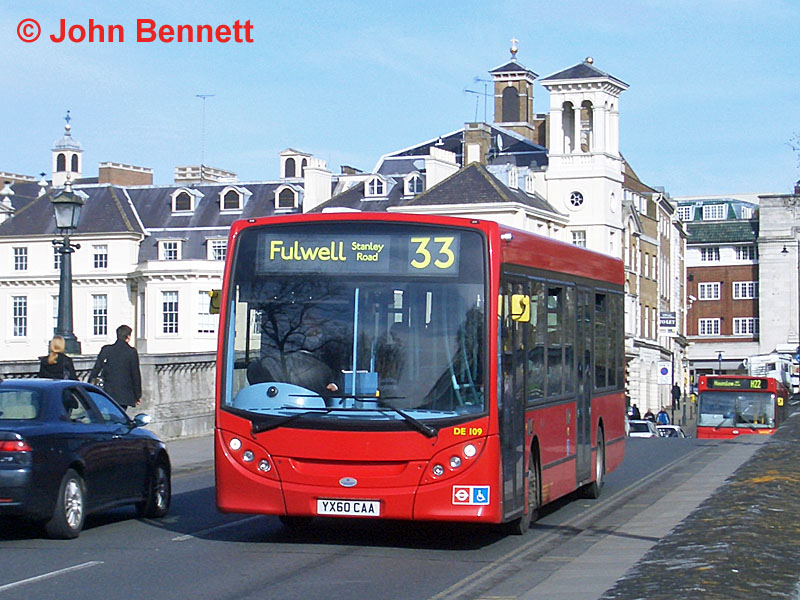 | Photo © John Bennett. |
Home | Bus routes | Operational details | Service changes | Operators & Garages | Photo gallery
A surprise tender result early in 2005 was the award of routes 33 and 419 from London United to National Car Parks (of all people!). 27 Dart SLF/Pointer 2s were obtained to work the routes, and a new base was established in Twickenham Trading Estate. (Rumours that the buses would be parked overnight in one of the firmís car parks proved unfounded!) Many of the managers were ex-London United employees. The buses were very similar to those previously used by London United, but were painted in allover red, and rather unimaginatively given the class code NCP.
Quite ironically, after having metamorphosed into NSL services limited, the company was sold to London United's parent Transdev, although initially as part of Transdev's London Sovereign operation, as Transdev was contemplating the possibility of disposing of London United, to RATP group of Paris. While the disposal went ahead (on 3 March 2011), in the event the two NCP/NSL garages also went with London United. Meanwhile, Transdev was successful in retaining the 33 contract in 2010, and new buses were specified. Enviro200Darts were ordered, and so DE109 (YX60 CAA) is seen on a sunny Thursday 24 February 2011 crossing Richmond Bridge. Note the lack of fleetnames, pending the corporate changes. Some of the buses displaced from the 33 have been transferred to the H22, and one is seen following.
 | Photo © John Bennett. |
Keen observers might note that some variations have started to appear in the Enviro200 bodywork style: the lower front panels on this batch curve out at the bottom. Some others, such as those on the 244 and B11 previously illustrated (but not these), also have an indent under the headlights, which makes a third variation!
As can be seen, the route now terminates at Fulwell, Stanley Road; previously it ran on round the corner to terminate in London Unitedís Fulwell garage forecourt, from where it was operated, but the change of operator meant a new terminus was needed, and closure of a former staff club located at the front of Travel Londonís premises on land owned by TfL provided the perfect opportunity. The shortened route also helped the reliability of the route, which had been performing quite badly for some time.
Low route numbers in London usually mean that a route has at least its origins in central London. The 33 is no exception, having been a Richmond Ė Aldwych service, operated by Mortlake and Twickenham garages, except on Sundays when the route was extended to Old Ford and operation shared between Clay Hall (Old Ford) and Middle Row (Kensington). There were also extensions at Summer weekends to Hampton Court. However, the section east of Hammersmith largely duplicated routes 73 and 9, and therefore from March 1937 the route was cut back to terminate at Brook Green, Hammersmith. By way of consolation, the 33 was extended from Richmond to Hounslow via Twickenham and Whitton, replacing route 27, and Hounslow garage became the main operator. Route 27 was reduced to run on Sundays only, and indeed on that day of the week the 33 was withdrawn.
For a few years in the 1960s, the 33 was replaced in its entirety by an extension of the 73 (thus Tottenham to Hounslow!) although the 33 was re-introduced on the same routeing from 1967.
Relatively recently, the section between Twickenham and Hounslow was taken off, being left to the 281. Just as, forty years previously, the 27 had been withdrawn from this section and diverted to run to Teddington (albeit in stages), now the 33 was diverted at Twickenham to run via Strawberry Hill to Teddington, with a projection to Fulwell, where was its new home garage. Thus, for the second time, the 33 replaced the 27!
In the last ten years, there has been much messing about with the frequency. Due to structural weakness the Hammersmith Bridge cannot now take double deckers, even though all the routes that cross it carry very heavy loads in peak times. This forced the conversion to little Dennis Darts, and a 10 minute service was run, suitably enhanced at peak hours. More recently, the service was enhanced between Richmond and Hammersmith, but the section out to Fulwell dropped to every 15 minutes. Then the full 7-8 minute service was extended to operate throughout, a considerable improvement, albeit at the expense of part of route 290 into Richmond. Later, the frequency was very slightly reduced to every 8 minutes.
Navigation
| Previous | Next | |
| Chronologically | 244 | 170 |
| Numerically | 32 | 34 |
Photo Gallery | Bus route list | Operational details | Service changes | Operators & Garages